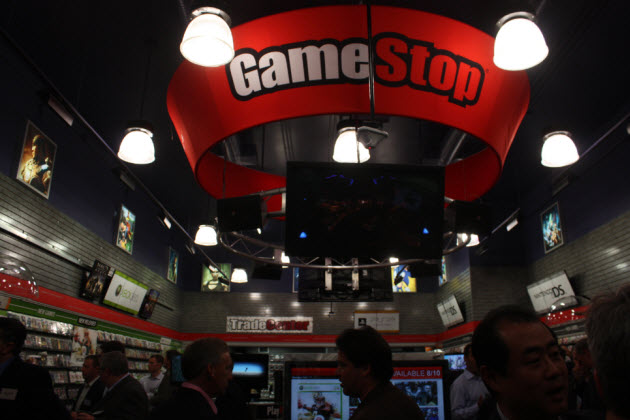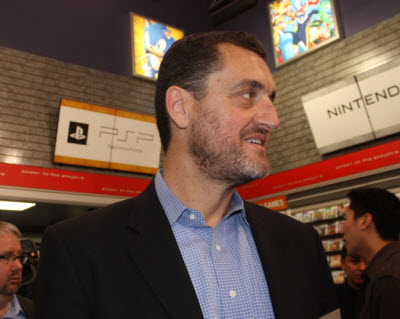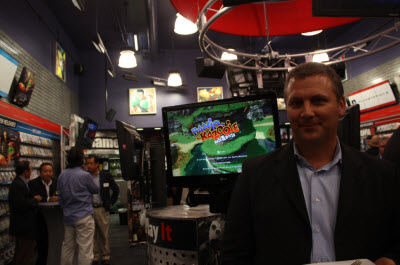
The top brass of GameStop, the world’s biggest video game store chain, dedicated their new “store of the future” on a cool strip of Palo Alto, Calif., tonight in the heart of Silicon Valley, where the assumption is that the dinosaur-like retail game chain is about to be “Netflixed.”
 That is, the technorati of Silicon Valley believe that brick-and-mortar video game stores — GameStop has more than 6,000 of them — are about to go the way of music and movie video stores. But J. Paul Raines (right), chief executive of Grapevine, Texas-based GameStop, the biggest retailer of games in the country, said that isn’t happening. On top of that, he says GameStop is moving fast to embrace the digital online future. Putting a flagship store in the middle of Silicon Valley, just down the street from digital distribution rival OnLive, is a stake in the ground.
That is, the technorati of Silicon Valley believe that brick-and-mortar video game stores — GameStop has more than 6,000 of them — are about to go the way of music and movie video stores. But J. Paul Raines (right), chief executive of Grapevine, Texas-based GameStop, the biggest retailer of games in the country, said that isn’t happening. On top of that, he says GameStop is moving fast to embrace the digital online future. Putting a flagship store in the middle of Silicon Valley, just down the street from digital distribution rival OnLive, is a stake in the ground.
The new store is a model for how GameStop will marry online games with packaged goods. It has downloadable and Flash-based games on a web-connected PC. It has reward program kiosks, big displays for watching demos, and all sorts of other technology.
Seeking to avoid the fate of Hollywood Video, the video-rental business that shut more than 2,000 stores and laid off more than 19,000 employees, GameStop has bought Kongregate, an indie online game portal. And it also acquired Jolt Online Gaming, a maker of free-to-play online games. Raines said that GameStop has more than 500 million visitors a year to its stores and can steer that foot traffic to its web sites and online gaming solutions.
 The founders of San Francisco-based Kongregate, Jim and Emily Greer (pictured), were on hand to show that their site was up and running using the store’s high-speed internet connection. Thanks to Kongregate’s traffic, GameStop now has another 10 million unique visitors a month to its already-popular web site. In the past, GameStop might have been lucky to monetize maybe 1 percent of its web site traffic. But with Kongregate and some serious efforts at monetization, the stores can help convert more of that traffic to loyal, paying customers, said Chris Petrovic (pictured below), general manager of GameStop Digital Ventures, which is preparing to invest $100 million a year in the online business.
The founders of San Francisco-based Kongregate, Jim and Emily Greer (pictured), were on hand to show that their site was up and running using the store’s high-speed internet connection. Thanks to Kongregate’s traffic, GameStop now has another 10 million unique visitors a month to its already-popular web site. In the past, GameStop might have been lucky to monetize maybe 1 percent of its web site traffic. But with Kongregate and some serious efforts at monetization, the stores can help convert more of that traffic to loyal, paying customers, said Chris Petrovic (pictured below), general manager of GameStop Digital Ventures, which is preparing to invest $100 million a year in the online business.
 The Palo Alto store is one of about 25 such stores that have already been built in marquee locations around the country. It shows how GameStop can keep its store customers more engaged through reward programs. The store is around 2,700-square-feet, or about twice the size of the typical GameStop store. There is plenty of space to walk around and watch game demos. There’s also a big trading center, where users can buy and sell their used games, which are now 31 percent of the chain’s sales.
The Palo Alto store is one of about 25 such stores that have already been built in marquee locations around the country. It shows how GameStop can keep its store customers more engaged through reward programs. The store is around 2,700-square-feet, or about twice the size of the typical GameStop store. There is plenty of space to walk around and watch game demos. There’s also a big trading center, where users can buy and sell their used games, which are now 31 percent of the chain’s sales.
Tony Bartel (pictured, below), president of GameStop, showed me and Nintendo’s head of sales and marketing, Cammie Dunaway, how the kiosks work. You walk up to the big display and show your PowerUp Rewards Pro card to an optical scanner. Your name comes up on the screen and then displays the games you’ve bought. It also shows your wish list and allows you to add to it. You do so by grabbing a game from the racks and scanning its barcode. The game instantly pops up on the Interactive Game Guide kiosk display (below). You can share the information with your friends. And GameStop can give you more rewards and achievements the more you spend at the store.
 Not only can you buy physical goods, you can also purchase downloadable content for your Xbox 360 or PlayStation 3 game console (the PS 3 is coming soon). Bartel showed how you could look up a Call of Duty Modern Warfare 2 game and then tap on the description, read reviews, or tap on the downloadable content. You can then purchase the content, swipe a credit card, and receive a validation code. Then you can go home and download the title. The content is priced the same as if you downloaded it at home, but if you buy it at GameStop, it counts toward your rewards.
Not only can you buy physical goods, you can also purchase downloadable content for your Xbox 360 or PlayStation 3 game console (the PS 3 is coming soon). Bartel showed how you could look up a Call of Duty Modern Warfare 2 game and then tap on the description, read reviews, or tap on the downloadable content. You can then purchase the content, swipe a credit card, and receive a validation code. Then you can go home and download the title. The content is priced the same as if you downloaded it at home, but if you buy it at GameStop, it counts toward your rewards.
Bartel said that early results show the PowerUp Rewards Pro is extremely popular with customers and that the kiosks are also a big draw. Dunaway asked how wide the demographic reach of the program is, given Nintendo’s audience is more mass market than hardcore. Bartel said that the results show that a broad swath of consumers are participating.
The company is in the midst of rolling out the kiosks as fast as it can. Although Raines and others say that digital distribution isn’t an insurmountable threat, there’s still pressure on earnings as traditional console game sales slow down. GameStop missed its earnings target in its most recent quarter.
 The digital strategy strikes me as wise and measured. But I’m still surprised that GameStop continues to open lots of stores. In the first half of the year, it opened 99 net new stores, adding some and closing older stores. Raines says the rate of store openings has slowed and that the chain will probably add a net of 2 percent expansion of store square footage in the U.S.
The digital strategy strikes me as wise and measured. But I’m still surprised that GameStop continues to open lots of stores. In the first half of the year, it opened 99 net new stores, adding some and closing older stores. Raines says the rate of store openings has slowed and that the chain will probably add a net of 2 percent expansion of store square footage in the U.S.
It’s likely that the chain is adding the stores in a measured way, signing short-term leases so it can close them quickly if needed. In that sense, the recession is aiding GameStop. It has plenty of prime storefronts to choose from these days and can tap the old Hollywood Video sites to open new flagship stores. But it better keep putting the pedal to the metal on the digital online expansion strategy, which includes acquiring new companies. The Greers acknowledge it’s a challenge, but they also say they know they are just the first big acquisition, not the last.
Bill Tai (pictured, right), a partner at Charles River Ventures, is an investor in online game companies such used game seller Glyde. He was at the opening, where he looked around and said, “They’re doing what they have to do to survive.”
VentureBeat's mission is to be a digital town square for technical decision-makers to gain knowledge about transformative enterprise technology and transact. Learn More
